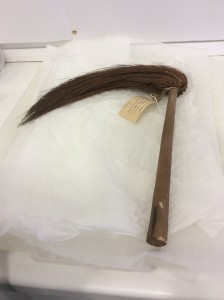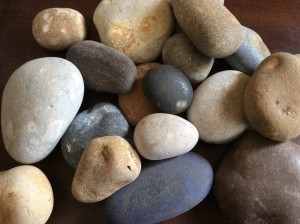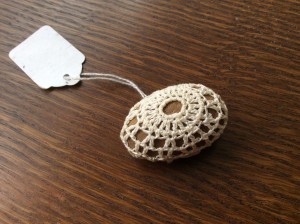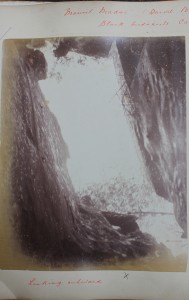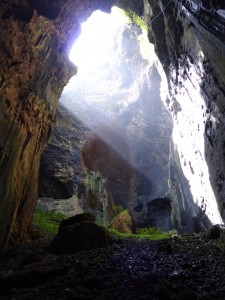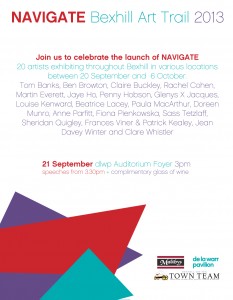From now until June I will be spending my Thursdays at Bexhill Museum as Artist in Residence. Working with artefacts and memories of my journey I will be connecting with Lady Annie Brassey and her travels. Inspired by the archives at Bexhill Museum (in particular Annie’s collection), this is an opportunity to revisit my journey in the context of Annie’s. With Annie as my companion for my travels it seems the ideal way to return to where I began. This time I know Annie a little better, I have written to her regularly, shared her journeys and visited places she has been.
Day one and I am returning to St Petersburg. The first point at which I crossed Annie’s path. She sailed to the Baltics in 1866, I took the train 147 years later. To be honest, I was just glad to get there, anything else in terms of exploration was a bonus. After four days of travelling I had spent two nights on a train, experienced an unnerving border crossing and had been stranded in Belarus in the middle of the night with neither local currency or language. Reaching the one place I had been to previously, it felt like a huge achievement and a familiar face all at once. To meet up here with Annie was lovely, it gave purpose to my stay. I visited the Botanical Gardens, remembered the Hermitage and completed an expedition in looking for a stamp to send a postcard back. My journey had begun.

The Church on Spilled Blood, Louise Kenward 2013
Setting up at the museum this morning I have a large wall space and long wide shelf the length of the wall. The possibilities are tantalising. I come armed with materials, equipment, books and artefacts. An empty tea tin with images of the city on it, a calendar from the Hermitage from my previous visit, tickets, postcards, two small 10 kopek coins, a small stone and three acorns from the Botanical Gardens and a leaf stitched into my diary because that’s where it fell while I was writing. Covering the wall in lining paper I enjoy writing and mind mapping, remembering my trip and Annie’s, and Bexhill’s connections with St Petersburg and Russia. Kate Marsden, nurse, missionary, explorer and writer, and (one of the) founder(s) of the Bexhill Museum joined me on my journey through Siberia. Equipped with fur coat and whistle she left Bexhill in 1891 in search for a cure for leprosy. I am working next to a case dedicated to Kate, there is a spectacular photograph of her wrapped up in many many layers of furs and animal skins. In a book with the same image it describes her wardrobe:
“Her get up consisted of Jaeger clothing; a down filled ulster covered by a sheepskin coat covered by a reindeer skin cloak in which she was unable to bend or to manoeuvre herself into a sleigh.” Hodgson, 2002
Kate was nonetheless very grateful for such clothing:
“I wish to thank you for having persuaded me to wear Jaeger Clothing. Humanly speaking I owe my life to that and not taking stimulants; and I really believe that no woman could have gone through all my dangers, privations and difficulties without both of these aids to health” (Advertisement, cited in Hodgson, 2002).
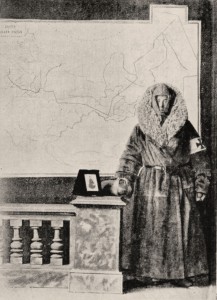
Kate Marsden in full travelling dress, image courtesy of Bexhill Museum.
Annie Brassey did not suffer such hardship in her travels. ‘Flight of the Meteor’ was published only privately (1866), so it is not possible to be certain, but her travels were not as a missionary with a view to curing leprosy and were generally more comfortable and with greater means than Kate. This isn’t to say that Annie’s travels were frivolous however, she supported many good causes and adopted an approach of education and publicity to a wider audience than Kate would have had access to.
Like Annie, I am a collector, unlike her, I collect with my heart rather than my head. Annie was more thoughtful about her collection, without sentiment she set out (and had means) to collect the finest examples of the finest objects. A collector in a different league to those of her era, she regarded objects as a curator does today, rather than a collector of her time. This brings an interesting dialogue at the outset between me and Annie. Today I have brought my few mementoes of St Petersburg, things connecting with the country and my journey. These included the three acorns, two small coins, stone and leaf from St Petersburg, a small plastic container with lip salve in the shape of a Russian doll given as a gift by a friend before I left (in a bid to find all things tiny). Some postcards and map from the Hermitage bought the previous time I’d visited the city, two oak leaves collected from inside my car which begged to be painted gold, a guidebook on St Petersburg, a map of the city, a metro token, a theatre ticket from attending the ballet and the memory of a small metal pin of an aeroplane that was a gift from a friend and was sadly irretrievably lost in St Petersburg. I took my letter to Annie and my blog posts, and crochet pebbles to ground me.
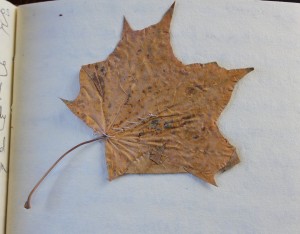
St Petersburg, leaf stitched into place where it fell. Louise Kenward, 2015
Surrounded by books and objects and with lining paper covering the wall I am soothed and have created a space within which I can explore. With a school visit there is little time or space to think about what I am doing. Their energy and enthusiasm is inspiring. I lower my shoulders and pick up a pen. The morning is spent drawing out thoughts and ideas, recollections and associations, a diagram of my thoughts and interests grow out of the wall. A welcome interruption and the museum curator, Julian Porter, shows me around all the Russian connections on display: a model of a Scourge ship sent to Russia during the First World War; some woolly mammoths, traditionally with a Siberian connection these were found at Eastbourne (long thought to be mole-like creatures because of the common discovery of them underground); a butterfly postcard (one of a series of allies and enemy forces) from World War I. Press cuttings had been found, connecting Bexhill and Russia: Bexhill Observer reports of the Northern Lights in June 1908, later discovered to be the effect from the meteor crash landing in Tunguska, Siberia; and the role the Mayor, a Mr Mayer, of Bexhill had in discovering Anna Pavlova.
I am wondering where to start, how to capture all this, what an incredible breadth of resource and knowledge is held at the museum, and in Julian’s head. I am amazed at how well connected Bexhill is to the rest of the world, and so many eras past, what happens when you scratch the surface. However, the magic is yet to be revealed. Within the archives a number of Russian coins, several from the time Annie would have visited, were found. A second rummage in the archives turns up nothing less than an emerald from the Brassey collection itself, complete with original label. This is Annie’s emerald, collected from Siberia. It is mighty, weighty and rather wonderful.

Brassey Collection, Bexhill Museum, Siberian Emerald (Louise Kenward, 2015)

Siberian Emerald, Brassey Collection, Bexhill Museum (Louise Kenward, 2015)
In Conversation with Annie is supported by an Award from the Heritage Lottery Fund.
